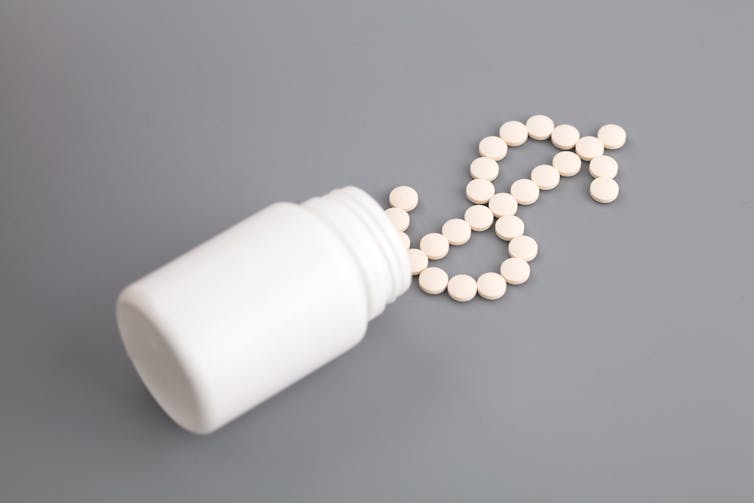
Patient groups should be playing a central role in Canada’s health-care system, advocating for their members by promoting the visibility of their conditions, pushing for more rapid and accurate diagnoses and lobbying for the introduction and funding of new treatments and drugs that may help relieve their members’ symptoms and extend their lives.
However, all of this requires resources. In the past, groups could turn to the federal government for funding, but that option dried up in the late 1980s and early 1990s.
Pharmaceutical industry funding
In response, patient groups looked to the pharmaceutical industry to be able to continue functioning. How much money Canadian groups get from drug companies is largely unknown.
Neither the federal government nor the major industry association, Innovative Medicines Canada (IMC), require companies to report on payments to groups and similarly there are no rules saying that patient groups must reveal who gives them money or how much. Even if groups are registered charities, that type of granular information is not collected in reports they have to file with the Canada Revenue Agency.

There is one source of partial information that has not been investigated until now. Since 2016, six companies have voluntarily released detailed annual statements about which groups they give money to and the value of those payments — GlaxoSmithKline, Merck, Novartis, Roche, Sanofi and Teva.
I have analyzed the available reports from these companies. Because pharma companies have a history of trying to buy influence — a topic I’ve researched extensively — it’s important to look at what and who they are funding. All told, from 2016 to 2023, they gave more than $30 million in 671 separate payments to 263 groups. The $30 million figure is a minimum because not all of the six companies report in any individual year. There are also an additional 42 member companies in IMC that don’t file any reports. (Teva does not belong to IMC.)
The median amount that a patient group received was $26,000 but that number hides the extremes. The Black Health Alliance received a single payment of $250 in 2023 from Novartis whereas the World Federation of Hemophilia, based in Montréal, got over $4.5 million from Roche and Sanofi between 2020 to 2023. Fourteen groups accounted for almost one-half of all payments groups received. Although Novartis only reported in three years (2021-23) it gave the largest amount of money, over $7.5 million.
Conflicts of interest
Receiving money creates a conflict-of-interest (COI), where a COI is defined by the U.S. Institute of Medicine (now the National Academy of Medicine) as “a set of circumstances that creates a risk that…judgment or actions regarding a primary interest will be unduly influenced by a secondary interest.” In this case, that would mean that the patient group was looking out for the interests of the drug company that gave it money as opposed to the interests of its patient members.
However, just because groups received money from drug companies does not necessarily equate to the positions and actions that they took. There is a wide range of positions taken by patient groups that have received pharma funding, and when their positions align with those of their sponsors, these associations do not establish cause and effect.
The Canadian Organization for Rare Disorders that received just shy of $450,000 between 2018 and 2023 from a combination of GlaxoSmithKline, Novartis, Roche and Sanofi has publicly criticized the legislation that potentially creates the first steps to a universal, first-dollar coverage pharmacare plan.
Twenty-eight patient groups, including Save Your Skin Foundation and Myeloma Canada, lobbied the Patented Medicine Prices Review Board to try to stop the board from instituting reforms to how it regulated drug prices. Save Your Skin Foundation got just over $750,000 in drug company money and Myeloma Canada got $831,000.

Some groups that take drug company money do not necessarily align with the interests of their funders. The president of the Canadian Spondylitis Association (CSA) pulled his organization out of a focus-group project organized by Janssen and AbbVie because he refused to sign off on a report claiming that patients were strongly opposed to switching from the medication Humira, sold by AbbVie, to a less expensive biosimilar.
Arthritis Consumer Experts (ACE) used to receive grants from Janssen and AbbVie until it also came out in favour of switching to biosimilars. (CSA received over $100,000 from Merck and Novartis, while ACE $267,000 from Merck and Novartis as well as Teva.)
How pharma funds buy influence
Pharma companies have a history of offering funding and other resources that have been shown to influence health-care professionals, which has extended the reach of pharma companies’ interests into virtually all aspects of health care. Funding patient groups may be another strategy to further extend the reach of those interests, which do not always align with those of patients and the public.
As a first step in trying to determine whose interests patient groups align with, we need more transparency about the source of their revenue. The European Federation of Pharmaceutical Industries and Associations (EFPIA) code requires that member companies disclose on their websites a list of patient organizations to which they provide financial support, the amount of the payment and a description of the nature of the support or services provided.
However, a study of industry payments in Nordic countries concluded that the EFPIA code fails to ensure transparency and compliance. EFPIA allows national industry associations the freedom to determine how its code will be implemented and how much oversight is required, leading to disparate transparency practices. EFPIA has not created a disclosure template to standardize reporting. Finally, EPFIA’s code does not apply to companies that are not members.
Industry codes are not the answer.
Before the Ontario election in 2019, the government was finalizing regulations for Bill 160 that required all drug and device manufacturers to disclose payments to patient groups. The legislative process stopped when the government changed post-election. The federal government should pick up the mandate on this issue and pass similar legislation to make reporting mandatory on a national basis.
Between 2021-2024, Joel Lexchin received payments for writing a brief on the role of promotion in generating prescriptions for a legal firm, for being on a panel about pharmacare and for co-writing an article for a peer-reviewed medical journal. He is a member of the Boards of Canadian Doctors for Medicare and the Canadian Health Coalition. He receives royalties from University of Toronto Press and James Lorimer & Co. Ltd. for books he has written.
This article was originally published on The Conversation. Read the original article.







